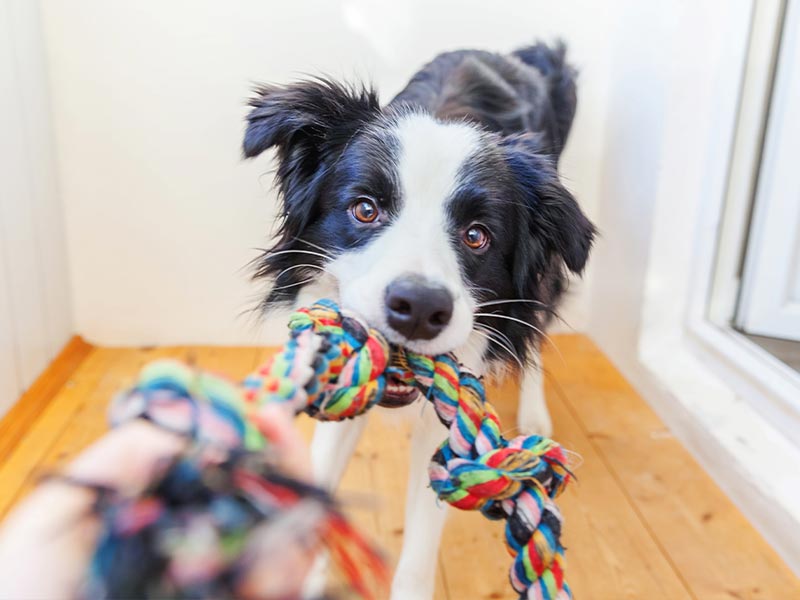

Many of us have adopted pups during this period of quarantine and working remotely.
Adding a furry friend to your family can be a wonderful, loving, and rewarding experience.
If you are considering adding a K-9 pal to your family, it pays to be prepared.
Here are some important things to keep in mind.
Puppies are a lot of work. Yes, for now at least, they are small, cuddly, and adorable. Who wouldn’t want to pick them up and take them home? Immediately.
But just like a person-baby, your dog-baby will require time, patience, and attention.
Before you bring home your furry bundle of joy, take time to go around the house and make the necessary changes that’ll prevent unnecessary damage while keeping your pup safe.
PROOFING INDOORS
- Be aware of foods that are especially poisonous or that can cause distress to a dog’s system. Make sure to keep raisins, grapes, sugarless gum, and chocolate out of reach, and do your best to be quick to pick them up immediately if they are dropped or spilled.
- Put all medications away and out of reach.
- Put electrical cords through concealers or unplug & move them out of reach.
- Keep doors and windows closed whenever you are unable to closely monitor your pup to prevent escape or injury.
- Keep toilet lids closed.
- Put cleaning supplies on upper shelves or behind secured/child locked doors.
- Put away small items that are choking hazards — such as coins, paper clips, rubber bands, and jewelry, LEGO, doll & action figure accessories, etc.
- Move poisonous houseplants out of reach.
- Keep all sharp, or pointy objects off the floor or low shelves.
- My new pup likes to trot around with pens pointy end out, like a cigar or those old-timey cigarette holder tube things.
- Lockdown your trashcans. Dogs are attracted to food-like smells coming from garbage, which can upset their tummies or even be poisonous.
- My veteran dog is partial to candy wrappers and the rookie has unfortunately taken to dryer sheets.
And like you may have done for your person-baby:
BONUS: Even with our largely temperate weather if your pup must stay outside for an extended period make sure you provide both shade and ample water to avoid heat-related injury and sickness. Regardless of their coat, they can be sunburned, especially around their ears, nose, and bellies.
PUP PROOFING OUTDOORS
- Secure the perimeter! Add a fence if you have the option, or repair/upgrade your existing one. Add height to match your dog’s jumping ability. It always pays to overestimate. Also, don’t assume that gaps at the bottom or side of the are small enough to keep in your new addition. Puppies are naturally curious and will do their best to explore their world.
- If you haven’t already, add a fence around an in-ground pool. These are extremely dangerous for puppies, especially when covered with light material.
- Keep up with the clean-up. Puppies have a penchant for eating their poop. It’s obviously not good for them, but there are few things viler than catching a whiff of a puppy poop burp.
- Just like your person-baby, always supervise your puppy. As we mentioned puppies are curious and prone to making terrible decisions. Take the opportunity to play and train them. For smaller breeds, or depending on where you live, it also lets you protect them from potential predators.
- Avoid using pesticides and insecticides if possible. If it can’t be avoided, keep your dog out yards recently treated with pesticides, insecticides, or fertilizer.
- Like indoors, remove toxic plants in your yard to prevent your pup from unfortunate snacking.
BONUS: Avoid feeding food from the table. Pups may look adorable as they beg for food, but many human foods are not good for them.
TEETHING
- Puppies begin to shed their baby teeth around the 12-week mark. Permanent, adult teeth start coming in at this point with the transition from baby teeth to permanent lasting about 6 months. Between 12 weeks and 6 months, it’s important to provide your new dog with a puppy safe outlet for chewing, like a Kong. Otherwise, they will find other ways to soothe their teething pains by gnawing on things around the house.
- Even with a Kong, mine has gnawed on a large plastic clamp and was in the process of putting his teeth on a Playstation controller when, from his perspective, he was rudely interrupted.
HOUSE TRAINING:
- House training normally takes 4-6 months, so make sure you have an ample supply of carpet cleaner and stain remover on hand as your pup settles into their routine.
- Consistency is key. Take them out regularly. If you have a yard, do your best to designate a part of it as a safe place for them to do their biz.
- With our puppy, we’ve found that giving a treat immediately following a successful potty has been highly motivating.
FIRST ENCOUNTERS
If you already have a dog in the household, here are some tips to start things off on the right foot when introducing them to future BFF (Best Furry Friend).
PREP
- Create safe spaces for both dogs with their own beds/crates and toys and discourage your existing pup from annexation. If your new family member isn’t a jumper, baby gates are a great way to keep a pet contained while allowing them room to move if they aren’t comfortable in a crate.
- Select a meeting place that is open so that neither pup feels boxed in, and therefore putting them on edge.
MEET CUTE
- For their encounter, bring each pup to the meeting place separately.
- Carefully bring the dogs together to greet each other. Don’t force it, making sure to give them enough lead so they don’t as if they are being restrained because that can trigger some dogs to understand it as the other dog is to be avoided or a potential threat.
- Anticipate a whole range of dog interactions. Sniffing, playing, circling, marking territory or pure indifference are all perfectly normal. It’s important to let them do what they want to do, barring overt aggression, with as little owner interference as possible.
- If aggression escalates to fighting, try to draw each party away with a treat instead of yanking them back as a first resort.
- Once the initial meeting is out of the way, take them on a short walk to increase familiarity.
- If the group walk is amicable, the pups could be ready to meet in the home.
CLOSE ENCOUNTERS
- After a successful intro, you can move towards less neutral territory.
- If you have a yard, that’s a good place to start.
- Remember to stay calm and casual as you continue to let them mix and hang out.
- If things have continued to progress positively, you can move things inside your home.
- As long as neither dog has shown overt aggression, let the resident dog off their leash first.
- If they mind their manners, you can let the newcomer off their leash as well.
- Keep an eye out for aggression territorial reactions from the resident dog. If they pop up, it’s best to provide a bit of separation as they adjust to the situation.
HONEYMOON PERIOD?
- Keep schedules and routines as close to your pre-pup version as possible.
- Mealtime, walks, potty time, playtime, etc.
- Regarding mealtime, for the first week or two, feed the new pup in a different room to avoid food competition.
- Make sure you dole out treats, love, and attention in equal measure.
- My resident dog wasn’t aggressive towards the puppy, in fact, she was and continues to be, excited to have an engaged playmate. HOWEVER, she was immediately insecure and wanted to be involved in any attention the little one was receiving. After several weeks of a concerted effort not to excessively fawn over the new dog, she’s able to let her little brother be the star.
- Even if they are otherwise friendly, please maintain supervision when they’re together.
- Furthermore, don’t leave them alone in the house together without a means to corral and separate them until you are confident they are comfortable with each other.
- Reinforce positive behavior with treats and affection.
- Continue to monitor their interactions as close as possible, looking for conflicts, or aggression over toys, territory, or other members of the family and intervene with distractions, or separation when necessary.
- Continue these steps and after time, the dogs should learn to co-exist and share the spotlight as beloved members of the family.
We hope that these tips get you off on the right foot with your new addition. While our advice comes from a variety of sources and personal experience, nothing beats working with trainers, veterinarians, and other professionals for advice specific to your pup.
You can also get ongoing breed and age-specific advice from the experts at the American Kennel Club. Head to AKC.org and sign up for their “Pupdate” and other newsletters.
And, of course, be sure to stop by your local Bartell’s for a variety of carpet and spot cleaners, not to mention local and national brand pet food, treats, toys, and other supplies.



